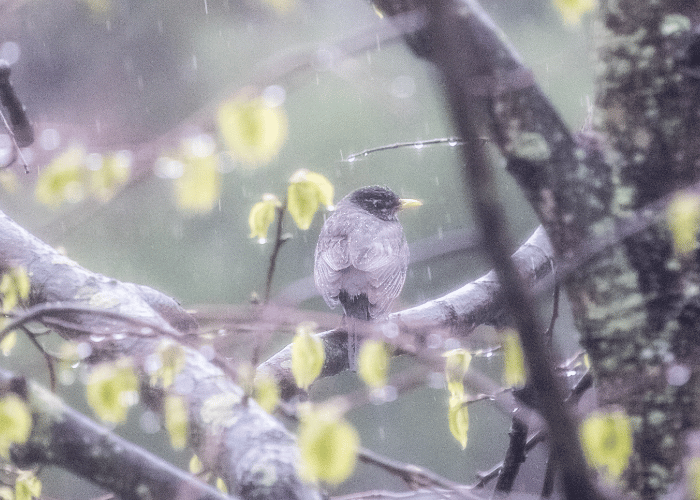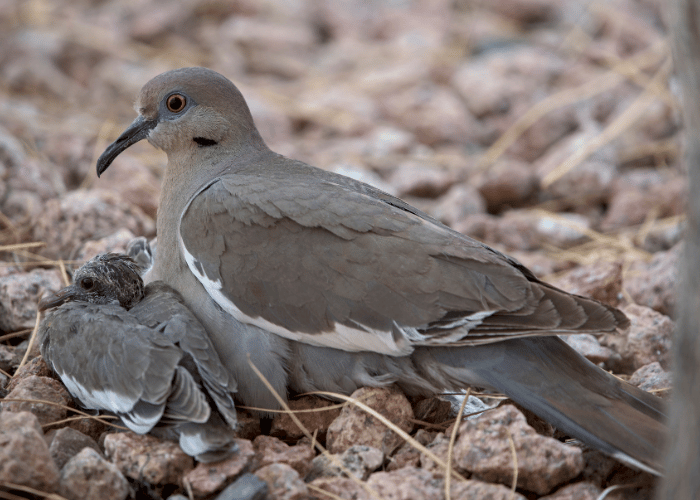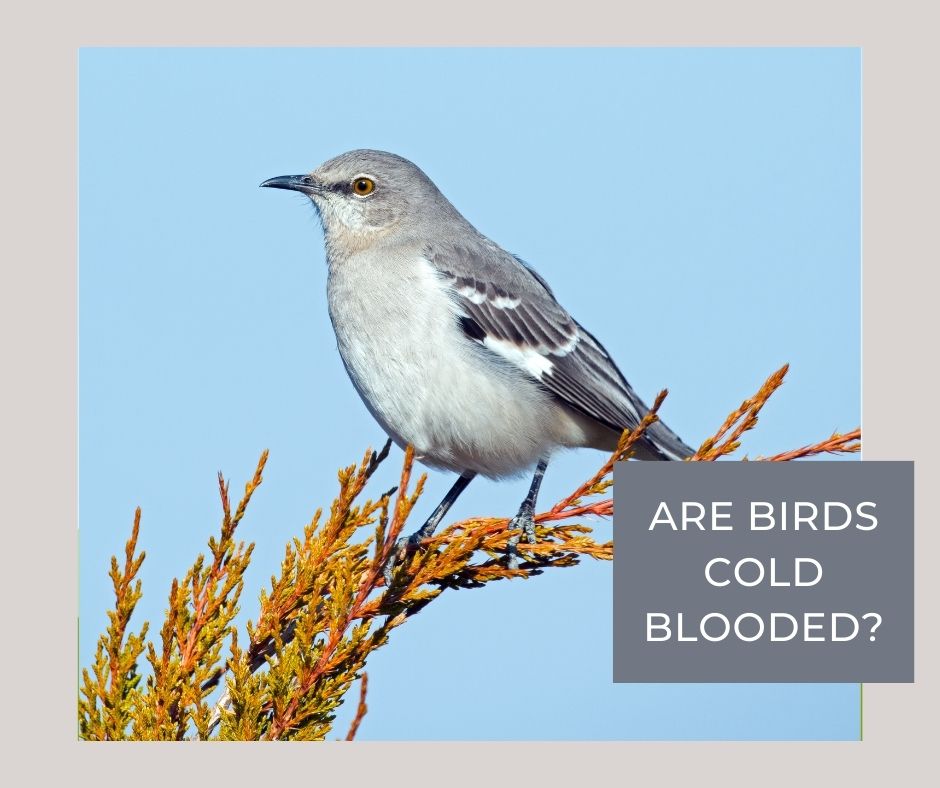Are Birds Cold Blooded
Table of Contents
Have you ever wondered, are birds cold blooded? How do these chirpy little creatures manage in the freezing winter or the scorching summer? Well, it’s high time we cleared up this mystery for you.
Contrary to the assumption of some, birds are not cold-blooded. Yep, that’s right. They are, in fact, warm-blooded. This means they are capable of maintaining a constant body temperature, independent of their surroundings. Unlike reptiles and amphibians, which are truly cold-blooded, the internal engines of birds keep chugging along pretty steadily.
But don’t take this as the end-all-be-all. While it’s true that birds are warm-blooded, it doesn’t mean they embrace winter’s chill with open wings, so to speak. They have some pretty interesting ways to cope with Mother Nature’s wild temperature swings. We hope this bit of information will spark a newfound appreciation for these feathered friends.

What Does ‘Cold Blooded’ Mean?
You’ve probably heard the term ‘cold-blooded’ thrown around when people talk about all sorts of creepy-crawlies like reptiles, insects, and of course, amphibians. But have you ever wondered exactly what that phrase means? It might paint a picture of a snake slithering in the snow or a frog hopping in a frigid pond, but let’s explode those frosty misconceptions here.
Being a cold-blooded creature isn’t anything to do with braving blizzards or chilly climates. It’s more about how the animal’s body manages its own temperature. Cold-blooded critters, not being able to regulate their internal body temperatures, depend on their external environment to do the job. Yep, you got it. Day in, day out, these animals hitch a temperature ride from their surroundings.
For example:
- If it’s a hot sunny day, that lizard basking on a rock is soaking up the heat to raise its body temperature.
- But come nightfall, when things cool down, sadly the lizard can’t keep that warmth. It becomes as cold as the chilly night.
Cold-blooded is a bit of a misleading term, because these creatures can be warm or cold, depending on where they are. A better scientific word is ectotherm, which means ‘external heat’.
Now, don’t get confused with their warm-blooded counterparts, like mammals and birds. Birds? You might wonder, they look very much like the ectotherms, don’t they? But we’ll divvy up the details about our feathery avian friends later in the article.
Of course, being cold-blooded or warm-blooded isn’t a matter of ‘good’ or ‘bad’. It’s just different ways that animals are adapted to survive in their world. Two sides of the same coin, you may say.
So by now, you’ve learned that being cold-blooded isn’t about wearing an ice crown or living in dark caves. It’s all about how an animal keeps its system running hot or cool. Take this nugget of knowledge, and get ready for more insights ahead. Trust me; it’s gonna be interesting!
Comparing Birds to Reptiles: Warm Blood vs Cold Blood
You may have heard the term “cold-blooded” before. It’s often used to describe reptiles – snakes, turtles, lizards. They’re called “cold-blooded” because their body temperatures adapt to their environment. In contrast, “warm-blooded” creatures, like birds and mammals, keep their internal temperature consistent no matter the weather outside. Here, we’ll dive deeper into the fascinating differences between the warm blood of birds and the cold blood of reptiles.
Ever wondered why you often see birds flitting around in the winter not seemingly bothered by the cold? That’s because birds are warm-blooded, or endothermic. It means they can control and maintain their body temperature internally, irrespective of the external environment. When it’s chilly, your friendly neighborhood robin has a metabolism that speed up to produce more heat, keeping it toasty even as snow flurries.
On flip side, reptiles are what we call cold-blooded, they’re ectothermic. This means, their body temperature largely depends on the exterior environment. So, a lizard basking on a sunlit rock is doing more than just enjoying itself—it’s warming up its body. That’s why you don’t usually see reptiles out and about when it’s cold. They don’t have the internal furnace birds and mammals do.
Let’s check out the comparison between birds and reptiles in more detail:
| Birds (warm-blooded) | Reptiles (cold-blooded) | |
|---|---|---|
| Body Heat | Maintain internally, remains constant | Dependent on environment, fluctuates |
| Energy Source | Need constant food to fuel | Can survive longer without food |
| Activity | Active in wide range of temperature | Limited activity in cold temperature |
Breaking it down:
- Birds will always keep a constant body temperature – typically, they’re naturally warm.
- Reptiles, are more like the room you’re in. If you turn up the heat, they get warmer. Turn down the thermostat? They cool down too.
While neither is necessarily better or worse, it is just part of what makes our animal kingdom so incredibly diverse and adaptable. From the frosty snowflake on a sparrow’s wing on a winter morning, to a sleek snake slithering over sunbaked rocks, each creature is amazingly suited to their way of life.

The Intriguing Physiology of Birds
Welcome to the wonderful world of birds! The characteristics of bird physiology are just as captivating as their vibrant colors, unique calls and flight skills. It might’ve crossed your mind whether birds are cold-blooded like their reptilian relatives or warm-blooded like furry mammals. Well, you’re in for a surprise.
Unlike their lizard and snake cousins, birds are actually warm-blooded just like us humans. They’re endothermic, meaning they generate their own body heat internally. This allows them to maintain a consistent body temperature, typically around 104 degrees Fahrenheit. This, my friend, allows them to brave the icy winters and scorching summers as if it’s just another day in the park.
It gets even more fascinating when you delve into ‘thermoregulation’, the process by which birds control their body temperature. It might get a little technical, but hey, it’s absolutely fascinating! Birds have a sequence of physical responses that help them stay temperate.
- There’s a ‘preen gland’ near their tails. Birds squeeze oil from this gland and spread it over their feathers. Think of it like natural insulation!
- They also have the ability to cool themselves down quickly thanks to their well-ventilated lungs and air sacs.
- Did you know birds can ‘fluff up’ their feathers to create air pockets that offer warmth? Clever, right?
Here’s a markdown table showing the basic difference:
| Warm-Blooded (Mammals & Birds) | Cold-Blooded (Reptiles) |
|---|---|
| Maintain constant body temperature | Body temperature changes with environment |
| Generate own body heat | Depend on external sources for heat |
No doubt about it, birds are extraordinary. Their impressive physiological traits add another layer to our admiration for these feathery friends. So next time you set out for some birdwatching, remember, there’s a whole lot more going on under those colorful feathers than meets the eye!
How Birds Maintain Their Body Temperature
You’ve probably wondered, on a brisk winter’s day, how do birds manage to stay warm? Birds, unlike us mammals, employ a unique and fascinating system to regulate their body temperature. They aren’t cold-blooded, but their adaptation skills are remarkable to ensure survival across a broad spectrum of climates.
Birds use a variety of mechanisms to maintain optimal body heat. Thermoregulation is the scientific term for this temperature control, and it comes in handy for our avian friends, since super cold or really hot temperatures hurt and risk their lives.
Thermogenesis is one mechanism to note here. When it’s freezing, birds produce heat internally by increasing their metabolic rate. They burn body fats, carbohydrates, and proteins for this process. There are two types: Resting Metabolic Rate (RMR) and Nonshivering Thermogenesis (NST). RMR is the energy used during rest, while NST is energy production in response to cold but without shivering.
You might know this, but birds have feathers! Yeah, they’re not just for looks. Feathers provide insulation against chilly weather. Birds puff up their feathers to trap air, creating an extra layer of warmth. This works like your fluffed-up quilt on a cold winter night.
And how can we forget the legs? Ever noticed how birds stand on one leg in cold weather? It’s called the rete mirabile, a counter flow heat exchange that reduces heat loss. By tucking one leg close to their body, birds conserve heat.
A bird’s diet also plays an essential role. High-fat foods provide more energy and thus more heat. So, when winter hits, birds chow down on seeds, nuts, and suet to keep the engine running warm.
So, you see, although they might appear fragile, birds possess a great deal of physiological armor against the elements. These resilience mechanisms are complex and finely tuned, enabling these feathered creatures to flourish in varying climates.
In conclusion, the answer to your original question “are birds cold blooded?” is a resounding no! Birds are well-equipped to control their body temperatures. They are up to the challenge of surviving in a wide range of climates, just like we mammals are. Next time you see a robin or a jay puffing out its feathers on a frigid day, you’ll know what’s happening. Our bird friends are out there staying warm, playing it cool, and staying alive in the most innovative ways.
Myths and Misconceptions about Birds and Cold Blood
Get ready, because we’re about to bust some myths about our feathered friends. The first big misconception about birds is the idea that they’re cold-blooded. Now, don’t feel bad if you’ve fallen for this one, it’s quite a common belief. But here’s the truth – birds are not cold-blooded. Instead, they’re warm-blooded, just like us humans.
Another false belief is that since birds are warm-blooded, they must feel the cold just as we do. But that’s not the case. Birds have developed some clever ways to deal with the cold. For instance, they can fluff up their feathers, creating air pockets for insulation, and some species can even lower their body temperature to conserve energy during harsh winter nights.
Just another heads up, the term ‘cold-blooded’ isn’t exactly accurate when describing any animal. In the scientific world, they prefer the terms ‘ectothermic’ and ‘endothermic’. Ectothermic animals, like reptiles, can’t regulate their body temperature internally, while endothermic animals, like birds and mammals, can.
You might also come across talk about certain birds exhibiting ‘cold-blooded’ behavior in certain conditions. This is a reference to torpor, a state of reduced metabolic activity some birds like hummingbirds enter in harsh conditions. But torpor in birds isn’t the same as being ‘cold-blooded’.
Here’s a quick breakdown:
| Terms | Animals | Can Regulate Body Temperature Internally? |
|---|---|---|
| Ectothermic (‘cold blooded’) | Reptiles | No |
| Endothermic (‘warm blooded’) | Birds, Mammals | Yes |
| Torpor | Some Bird species | N/A (temporary state of reduced activity) |
So don’t let the myths fool you. Birds are rather fascinating creatures, with abilities and features that allow them to survive, and even thrive, in conditions that would leave us bundling up for warmth. Just remember, they’re not ‘cold-blooded’, they’re just cool!

Wrapping Things Up: Are Birds Cold Blooded?
You’ve journeyed a long way through this feathered debate. So let’s dig right into the final question you’ve all been waiting for: are birds cold-blooded? You might have wondered this after seeing a duck paddling in a freezing pond or a sparrow frisking in the snow.
The clear-cut answer is no, birds aren’t cold-blooded. They’re a part of a group called endotherms (also known as warm-blooded). This unique trait helps birds maintain a stable body temperature regardless of the environmental conditions. You’ll find a typical bird body temperature fluctuates around 104-110°F (40-43°C) – much higher than ours!
Now, you might ask, “What’s the difference then? Aren’t all creatures warm or cold blooded?” Absolutely not. Here’s a breakdown:
- Endotherms (Warm-blooded Creatures): Birds and mammals belong to this group. They generate heat from within and can regulate their body temperature.
- Ectotherms (Cold-blooded Creatures): Ectotherms are primarily invertebrates, fish, amphibians, and reptiles. They absorb heat from their surroundings and their body temperature varies with the environment.
- Heterotherms: This category includes some mammals, birds, and invertebrates. Their metabolic heat production and body temperature regulation shifts between that of endotherms and ectotherms, depending on factors like activity level or time of day.
It’s a fascinating fact that this warm-blooded feature gives birds the flexibility to fly high and fast, migrate great distances, and thrive in diverse environments.
So, next time you spot a bird soaring high in the wintry sky, you’ll know it’s not standing the cold – it’s embracing the chill with its warm-blooded nature!
Isn’t nature just incredibly wonderful?






